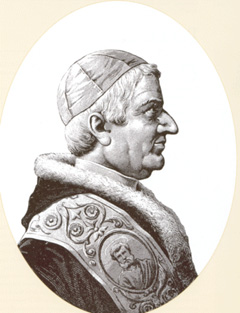| Pope Gregory XVI  AKA Bartolomeo Alberto Cappellari AKA Bartolomeo Alberto Cappellari
Born: 18-Sep-1765
Birthplace: Belluno, Italy
Died: 1-Jun-1846
Location of death: Rome, Italy
Cause of death: Cancer - unspecified
Gender: Male
Religion: Roman Catholic
Race or Ethnicity: White
Occupation: Religion Nationality: Italy
Executive summary: Papal spendthrift, hated railroads Gregory XVI, pope from 1831 to 1846, was born Bartolommeo Alberto Cappellari at Belluno on the 18th of September 1765, and at an eariy age entered the order of the Camaldoli, among whom he rapidly gained distinction for his theological and linguistic acquirements. His first appearance before a wider public was in 1799, when he published against the Italian Jansenists a controversial work entitled Il Trionfo della Santa Sede, which, besides passing through several editions in Italy, has been translated into several European languages. In 1800 he became a member of the Academy of the Catholic Religion, founded by Pope Pius VII, to which he contributed a number of memoirs on theological and philosophical questions and in 1805 was made abbot of San Gregorio on the Caelian Hill. When Pius VII was carried off from Rome in 1809, Cappellari withdrew to Murano, near Venice, and in 1814, with some other members of his order, he removed to Padua; but soon after the restoration of the pope he was recalled to Rome, where he received successive appointments as vicar-general of the Camaldoli, councillor of the Inquisition, prefect of the Propaganda, and examiner of bishops. In March 1825 he was created cardinal by Pope Leo XII, and shortly afterwards was entrusted with an important mission to adjust a concordat regarding the interests of the Catholics of Belgium and the Protestants of Holland. On the 2nd of February 1831 he was, after sixty-four days conclave, unexpectedly chosen to succeed Pope Pius VIII in the papal chair. The revolution of 1830 had just inflicted a severe blow on the ecclesiastical party in France, and almost the first act of the new government there was to seize Ancona, thus throwing all Italy, and particularly the Papal States, into an excited condition which seemed to demand strongly repressive measures. In the course of the struggle which ensued it was more than once necessary to call in the Austrian bayonets. The reactionaries in power put off their promised reforms so persistently as to anger even Metternich; nor did the replacement of Bernetti by Lambruschini in 1836 mend matters; for the new cardinal secretary of state objected even to railways and illuminating gas, and was liberal chiefly in his employment of spies and of prisons. The embarrassed financial condition in which Gregory left the Papal States makes it doubtful how far his lavish expenditure in architectural and engineering works, and his magnificent patronage of learning in the hands of Mai, Mezzofanti, Gateano, Moroni, and others, were for the real benefit of his subjects. The years of his pontificate were marked by the steady development and diffusion of those Ultramontane ideas which were ultimately formulated, under the presidency of his successor Pope Pius IX, by the Council of the Vatican. He died on the 1st of June 1846.
Father: Giovanni Battista
Mother: Giulia Cesa-Pagani
Roman Catholic Pope 6-Feb-1831 to 1-Jun-1846
Papal Inquisition
Requires Flash 7+ and Javascript.
Do you know something we don't?
Submit a correction or make a comment about this profile
Copyright ©2019 Soylent Communications
|